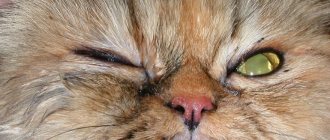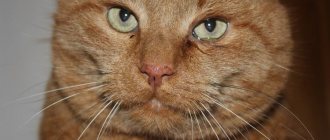A cat's health can be judged with confidence by its appearance. The organs of vision are the first to react to its deterioration. The eyes of a healthy cat are bright, clean, without traces of discharge in the corners. And if their condition is far from ideal, we can assume that the animal is sick.
Red eye syndrome in cats is a very common symptom. It often indicates ophthalmological problems, and sometimes indicates a somatic disease. Reddened protein in most cases is accompanied by itching, burning, lacrimation, photophobia, hemorrhages in the iris, and blepharospasm. Red, inflamed eyes indicate that blood circulation in their choroid is impaired, the blood vessels are dilated, and the surrounding tissues are inflamed. From this article you will learn what causes eye redness and what to do to help your cat.
Mycoplasmosis
Mycoplasma is a special type of microorganisms that occupy an intermediate position between bacteria and viruses.
In almost 90% of healthy cats this microorganism can be isolated, i.e. it is a normal inhabitant of the conjunctiva in cats. Mycoplasmosis in cats is an infectious disease that is characterized by the development of bilateral conjunctivitis with severe redness (hyperemia) of the entire conjunctiva, including the third eyelid.
Symptoms:
- Discharge from the eyes (tears, mucous or purulent discharge).
- Redness of the eyes.
- Sneezing, nasal discharge, and cough may occur.
— If both eyes of an animal are affected almost simultaneously, this indicates the infectious nature of the disease. If only one eye waters and turns red, then most likely it is conjunctivitis of non-contagious etiology. Often, mycoplasmosis in a cat disappears on its own after 7-10 days (if the underlying disease is eliminated and the immune system is strengthened). Otherwise, the disease becomes chronic.
- Joints are affected. At first the animal limps on one leg. Then it becomes noticeable that all the paws hurt. Mustache runs/jumps less. Getting up/ascending/descending becomes extremely difficult for the cat, so he sleeps almost all the time or lies down, meowing pitifully. The joints swell and do not bend.
- Body temperature rises.
Treatment
1. Treatment of the underlying infection using antibiotics and immunostimulants.
2. To treat conjunctivitis - eye drops with antibiotics.
============================================================================================================================================================================================
Causes of redness in cat eyes
Let's consider the possible reasons for the appearance of red eyes in a cat:
- Foreign body in the eye
. If a cat's eye is red and watery, then the reason may lie, for example, in a small pebble or speck that got into the animal's eye. You can determine that a cat has a foreign body in the eye by the following signs: usually only one eye is affected (and the other looks healthy), there is profuse lacrimation and redness, swelling around the eye, in some situations red or yellow discharge from the eye may appear, shaking the head and rubbing the eye with a paw, anxiety; - Eye irritation
. It happens that an adult animal or a kitten has red eyes due to some external influence. For example, tobacco smoke (in cats whose owners regularly smoke without going out into the fresh air) or cosmetics (pet shampoos) can cause eye irritation. May cause irritation and dust. If an animal blinks frequently, and its eyes are itchy, watery and red (both eyes at once), then irritation may be to blame; - Conjunctivitis
. A cat's eyes may be red due to inflammation of their mucous membrane. There are many reasons for the development of conjunctivitis: often the disease occurs against the background of allergies, due to regular eye irritation or due to a foreign body. In addition, this eye disease often occurs as a secondary ailment after an infection. Signs of conjunctivitis include redness of the eyes (both), swelling of the eyelids, discharge of clear and sometimes purulent secretion from the eyes (the area under the eyes is constantly wet), sticking of the eyes (due to dried pus), photophobia, and apathy. In some situations, a rise in temperature is possible; - Keratitis
. The cat's eye is red and watery due to inflammation of the cornea. The main causes of this disease include eye injuries, eye infections and allergies. In addition, some breeds are predisposed to the disease, for example, Siamese, Burmese, Persian. The main symptoms of this disease are redness of both eyes, the release of a large amount of tears or pus, clouding and roughness of the cornea, frequent blinking, itching, fear of bright light, sneezing and a runny nose are also possible, and sometimes the temperature rises; - Blepharitis
. Redness of the eyes is also possible with inflammation of the eyelids (the disease usually affects the eyelids of both eyes). The causes of blepharitis include infectious diseases, eye injuries, vitamin deficiency, and allergies. The main symptoms of blepharitis include, in addition to redness of the eyes, severe swelling of the eyelids, discharge of a large amount of pus from the eyes, peeling and sticking of eyelashes and hair, the formation of ulcers at the edges of the eyes, severe itching (cats rub their faces against pieces of furniture or rub their eyes with their paws). In severe cases, the temperature may rise; - Uveitis
. A cat's eye may be red due to inflammation of the choroid. Most often, the disease develops due to eye injury, autoimmune diseases (for example, lupus erythematosus or vasculitis), eye tumors, and other eye diseases (keratitis, conjunctivitis, etc.). How can you tell if your cat has uveitis? At first, the disease can be confused with a relatively harmless conjunctivitis, but then the following characteristic signs will be added to the redness and swelling of the eyelids with discharge: decreased vision, photophobia, discoloration and protrusion of the iris, entropion of the eyelids, strabismus, change (severe narrowing) in the shape of the pupil, severe itching , development of glaucoma or cataracts. Possible rise in temperature and refusal of food; - Entropion
. Redness of the eye (usually one, not both) often occurs when the eyelids are turned up, when the corneal layer is constantly injured by hairs or eyelashes. The main causes of entropion are genetic predisposition (in the British, Persians, Sphinxes), eyelid defects, eye injuries (including chemical and thermal burns), and paralysis of the facial nerve. Symptoms of the disease include (in addition to redness of the conjunctiva) pain, lacrimation or excessive discharge of pus, swelling of the palpebral fissure, constantly wet fur under the eye, the appearance of ulcers on the cornea, frequent blinking and squinting of the eye; - Glaucoma
. Redness in one or both eyes may be caused by increased intraocular pressure. In some situations, if both eyes are affected, the cause of the disease is considered to be genetic (the disease especially often affects Siamese and Burmese cats). If only one eye is sick, then most often this is caused by untreated uveitis. The most striking signs of glaucoma in cats are severe clouding of the eye, dilation of the pupil, an increase in the diameter of one or both eyes, swelling of the eyelids, severe tearing, fear of light, lethargy, and pain in the eyes. Sometimes vomiting may be present; - Dry eye syndrome
. Sometimes the redness of a cat's eye is associated with insufficient hydration of the conjunctiva and cornea by tear fluid. There are many reasons for this disease: infectious eye diseases (including keratitis, conjunctivitis), autoimmune diseases, kidney problems, endocrine disorders, vitamin deficiency. With the problem under discussion, the cat’s eyes turn red, the animal cannot look at the light and stay in the wind for a long time, constantly squints, rubs its eyes with its paw, at the initial stage active lacrimation is possible, but later there is no discharge from the eyes, erosions form on the cornea, vision deteriorates; - Dacryocystitis
. Brown or red discharge from a cat's eyes occurs due to non-infectious inflammation of the lacrimal sacs. Most often, the disease is provoked by any inflammatory ailments of structures close to the eyes (for example, sinusitis or sinusitis). The main signs of dacryocystitis include severe swelling of the lacrimal sac (due to the accumulation of a large amount of pus in it), the formation of fistulas on the eyelid, gluing of the eyelids and eyelashes from pus, the formation of crusts on the eyes, pain and severe itching, as well as redness of the eyes. Note that the disease can affect either one or both eyes; - Eye injuries
. If your cat has red around the eye, it may be due to injury, such as from a fight with other animals, plant thorns getting into the eye, or scratches from small pebbles. Sometimes a cat’s eye can be damaged due to a collision with a vehicle; unfortunately, human “fun” is also possible when something sharp is poked into the animal’s eye. You can recognize an eye injury by the following symptoms: severe redness (usually only one eye), severe lacrimation, which without treatment turns into discharge of pus, bleeding from the eye, swelling of the eyelids, clouding of the eye, protrusion of the third eyelid, severe itching. In some situations, blindness may develop: the cat, wandering around the house, will bump into pieces of furniture and stagger. - We have listed the most common causes of eye redness. But it is not always worth looking for the root of the problem in eye diseases. So, the cause of red eyes may be an allergy (for example, to food or veterinary medications). If the animal has a red spot above the eye, then the liver may be acting up. A cat may have red eyes due to illnesses such as chlamydia, rhinotracheitis, mycoplasmosis, and calcivirosis. An animal may also have red white eyes due to helminthiasis. But if the eyes glow red, then you shouldn’t worry too much: in some cats (especially Siamese) this is considered normal.
Symblepharon
Symblepharon is a fusion of the conjunctiva with the eyelids and cornea.
Symptoms:
Symblepharon varies in area of damage and localization: it can be partial or complete.
If it is small in size, it is sometimes an accidental finding during a general examination, but if it is of a significant size, it is already a cosmetic defect and interferes with the cat’s vision, but the symblepharon itself does not bother the cat.
With partial symblepharon, when the conjunctiva may not fuse with the cornea, the prognosis is favorable; with complete symblepharon, the prognosis is most often unfavorable.
Treatment:
1. Daily eye sanitation.
2. Separation of the conjunctiva from adjacent layers, the cornea, using local preparations with antibiotics and steroidal anti-inflammatory drugs.
3. In case of severe symblepharon, leading to visual impairment, the option of surgical treatment to separate the fused tissues is considered.
============================================================================================================================================================================================
Consequences of diseases
If an animal suffers from conjunctivitis, there is no need to worry about its vision. Much more dangerous is glaucoma, which leads to blindness, and anterior uveitis, which causes swelling of the cornea and other consequences that also negatively affect vision.
It should be remembered that some eye diseases, as well as their treatment, differ in cats and dogs; this fully applies to conjunctivitis, so the treatment is also different. In cats, the main causative agent of the disease is the herpes virus; in dogs, it is constant irritation of the eyelids or eyelashes.
Diagnosis and treatment
A veterinarian can examine and identify signs of the disease using a slit lamp and an ophthalmoscope, but for a more thorough examination the following examinations can be used:
- Staining the cornea with fluorescein. To detect damage.
- Tonometry. For measuring pressure.
- Seidel test.
- Schirmer test. Check for lacrimation.
- Cytology, ultrasound of the eyes. Checking the condition of intraocular structures.
- Cranial x-ray.
- CT and MRI of the head.
As well as the causes of “red eye”, that is, various diseases, there are many ways to treat them, it all depends on the specific case. A cure may require a week's course of eye drops; in other cases, surgery will be necessary. Sometimes treatment requires giving your pet medications for life.
Occasionally, red eyes indicate infectious diseases that threaten the lives of animals, so identifying the root cause helps to stop the development of extremely serious illnesses in time.
Obstruction of the nasolacrimal duct
Normally, tears should flow out through a special channel that runs inside the nose (nasolacrimal duct), but if this outflow path is disrupted, the tear has nowhere else to flow except outward, to the area near the eyes.
Symptoms:
- Various degrees of lacrimation and brown coloration of the fur around the eyes (formation of “tear tracks”).
This may be a breed predisposition - as congenital pathology is often found in Sphynx, Persian, British, exotic, Scottish and other short-faced cats; or as a consequence of inflammatory processes in the eye area.
Treatment:
1. If the obstruction is associated with overgrowth or blockage of the nasolacrimal duct, then surgical dilation of the canal is possible. 2. But most often, with this problem, it is enough to carry out daily hygienic care using special lotions to remove tear ducts.
===========================================================================================================================================================================================
How to treat conjunctivitis in cats?
Treatment begins with an initial examination of the thin lining of the cat's eyeballs and the inside of the eyelids. The mucous membrane of the upper eyelid (conjunctiva) in a cat resembles a pad. There are many ducts of the lacrimal glands here.
Functions of the ducts:
- Do not allow the eye to dry out.
- Wash away any small particles that get into your eyes.
If you look closely at the inner corners of a cat's eyes, you'll see another layer of mucus. When inflamed, it becomes especially noticeable. This is conjunctivitis - an inflammatory process of the conjunctiva that protects the eye.
Conjunctivitis
This is an inflammation of the outer layer of the eye, which is normally pink in color.
Symptoms:
- Redness of the eye,
— Discharge (can be transparent in the form of a tear, mucous, purulent)
- Squinting of the eye, local itching.
Treatment:
1. Use of local and systemic antibiotics and antiviral, and, if necessary, local antiallergic drugs.
============================================================================================================================================================================================
Diagnostics
Your veterinarian may order some tests, which include testing for the condition that causes red eye. The doctor will take your medical history and perform a physical examination to determine the underlying problem.
A complete ophthalmic examination is necessary to find the source of the eye redness. Your veterinarian may refer your pet to a veterinary ophthalmologist to evaluate your pet's condition using specialized equipment. During an eye exam, the following tests may be performed:
- Schirmer test for measuring tear quantity
- Fluorescein staining of the cornea to detect abscesses
- Tonometry to measure eye pressure
- Examination of the inside of the eye under magnification
- Scraping of inflamed tissue (eg, conjunctiva and cornea) for cytological examination for the presence of inflammation
- Eyelid scrapings to detect parasites
- Taking tissue samples to check for infections
- Biopsy of inflammation around the eyes
Protrusion (loss) of the third eyelid gland
Symptoms:
— A red or pink formation appears in the inner corner of one or both eyes.
- Discharge is usually in the form of tears or mucus in small quantities.
Treatment:
1. Surgical, preference is given to repositioning the gland rather than removing it, since this gland accounts for 30 to 50% of the total amount of tears produced.
============================================================================================================================================================================================
Preparing for going to the clinic and treatment
0 Source:
Before going to the doctor, you need to write down or note for yourself exactly when the lacrimation began, which eye began to water first, the nature of the discharge, the animal’s diet in the last few days, treatment, vaccination or surgery in the recent past, the presence of additional symptoms. This will allow the veterinarian to quickly make the correct diagnosis and prescribe effective therapy. Typically, veterinarians prescribe drugs such as furatsilin, chloramphenicol, sofradex and kanamycin, which must be used in accordance with the instructions. To speed up recovery and alleviate the animal’s condition, you can resort to auxiliary therapy, unless, of course, we are talking about a bruise or allergy, and not a serious disease of the visual organs. Eyes can be washed with furatsilin solution, infusion of calendula or chamomile, and even regular black tea. These products have an antibacterial and soothing effect. Gently wipe the eyelid area with a cotton pad soaked in the infusion, remove the crusts and drip the medicine. During manipulations, it is advisable to seek the help of someone close to you. If this is not possible, the animal must be tightly secured, for example, with a scarf. It is important to speak kindly and calmly to the cat during manipulations, so as not to scare the animal, and be sure to reward it with some kind of treat upon completion.
Entropion of the eyelids
This is an incorrect position of the upper and/or lower eyelids, in which the free edge of the eyelid is shifted inward towards the eyeball.
Symptoms:
— Eyelashes and hair on the eyelids, when turned in, greatly irritate the eye.
— The cat squints its eyes a lot.
- There is severe lacrimation or purulent discharge. Constant irritation can lead to corneal injury.
Treatment:
1. Surgical. With spastic volvulus, therapy is aimed at eliminating the underlying disease, but in some cases, after eliminating the cause that caused the spastic volvulus, it is still necessary to resort to surgical correction.
============================================================================================================================================================================================
Main types of disease
Any inflammation of the eyelid mucosa begins as catarrhal conjunctivitis, which can develop into a more serious form of pathology. To prevent this from happening, immediately contact your veterinarian to find out the source of the inflammation!
Catarrhal form
The least dangerous species for the animal, but requires complex treatment. Only the veterinarian determines the course! If proper measures are not taken, various complications are possible. Mucus (catarrh) is supplemented by purulent discharge from the eyes. If your animal has redness, swelling, eyelid inversion, or tearfulness, contact a specialist. To successfully treat a cat, it is important to stop the inflammation in time.
Purulent form
Yellow crusts in the morning may indicate the beginning of the process. The appearance of yellow or yellow-green pus and sticking of the eyelids already indicate a dangerous development of the disease. It could be an infection, and inflammation is a symptom. Avoid even more serious complications.
Phlegmonous form
There is discharge of pus outward and into the subepithelial layer. Treatment is very difficult even with the help of an experienced veterinarian.
Follicular form
The mucous membrane of the eyelid and the lymphatic follicles on the inside become inflamed. Protrusion is observed. Follicular conjunctivitis requires long-term therapy, and sometimes surgical removal of the follicles. After this, the cats are prescribed antibiotics and eye drops.
Corneal ulcer
This is an inflammation of the cornea, accompanied by its defect.
Symptoms:
- Squinting (blepharospasm)
- Watery or purulent discharge, pain.
— You may notice a roughness, indentation, or whitish spot on the surface of the cornea.
Treatment:
Depending on the severity of the process:
1. Medication (antibiotics, keratoprotectors, etc.)
2. Surgical.
============================================================================================================================================================================================
Prevention of eye diseases
Of course, no cat can be completely immune from diseases of the organs of vision, but it is within the power of a person to do everything to ensure that the risks of such diseases are as small as possible. To do this, it is necessary to provide proper care for your pet’s eyes.
To prevent bacteria from multiplying in the mucus that periodically accumulates in the corners of the cat’s eyes, this mucus must be removed. To do this, you can use special disinfectant eye lotions or herbal decoctions.
When bathing your pet, you need to make sure that the soap solution and water do not get into her eyes and do not irritate them. The same precautions should be taken when treating your furry beauty against fleas and other parasites with insecticidal drops and powders.
If the domestic predator is a long-haired breed, you need to pay attention to the length of the hair above the cat’s eyes. If the hair hangs over, then it can scratch its delicate conjunctiva unnoticed by a person, but extremely noticeably for a cat, injuring them and, as a result, causing redness.
When performing any procedures on a cat’s eyes, the owner needs to be very careful not to scratch or damage the delicate organ of vision. Do not use dry wipes or cotton wool, as their fibers may get into your eyes. It is best to moisten a napkin or cotton wool in a special eye solution intended for cleaning or in a weak chamomile decoction.
Uveitis
Inflammation of the iris and ciliary body - structures located inside the eye.
Symptoms:
- Squinting, redness and clouding of the eye.
- Constriction of the pupil.
— Precipitates on the corneal endothelium (small white dots on the inner surface of the cornea)
— Exudate (effusion) in the anterior chamber of the eye
- Decrease in intraocular pressure.
Treatment:
1. Local corticosteroids, non-steroidal anti-inflammatory drugs, mydriatics and systemic drugs.
===========================================================================================================================================================================================
Symptoms
Most cats diagnosed with hyphema have some degree of vision problems and discomfort. In cats, due to hemorrhages, visual acuity decreases and vision deteriorates.
- frequent blinking, squinting of eyes;
- tearfulness;
- inadequate reaction to pupil light;
- changes in behavior (depression, apathy, drowsiness, inactivity);
- pupil dilation;
- redness of the mucous membrane;
- swelling of the eyelids;
- decreased vision (monocular blindness if one eye is affected).
Important! Some cats experience acute pain and severe discomfort when opening or closing their eyes.
Glaucoma
This is an increase in intraocular pressure due to a decrease in the outflow of intraocular fluid. This pathology leads to a narrowing of the visual fields, and ultimately to complete loss of vision. Glaucoma can be primary or secondary (against the background of the underlying disease). In cats, glaucoma most often occurs after the age of 6 years and is secondary.
Symptoms:
- Redness of the eye
- Watery eyes, squinting (blepharospasm)
- Pupil dilation and signs of concomitant disease (uveitis, tumors) may be observed.
— In the case of an acute attack of glaucoma, the eye becomes cloudy, tortuous vessels on the surface of the eye are clearly visible and severe pain, the eye may increase in size.
Treatment:
1. Drugs to lower intraocular pressure.
============================================================================================================================================================================================
Preventive actions
Among the basic rules of prevention are the following:
- Carefully ensure that the cat does not injure its eyes when playing with other animals.
- When swimming, do not allow detergents to get into your eyes. This often leads to irritation.
- Hygienic procedures are carried out using products that do not provoke the development of an allergic reaction.
- Regularly wipe the corners of the animal's eyes with cotton swabs.
- Avoid getting hair in the eyes of long-haired animals.
Swelling and redness are the first symptoms of the onset of the inflammatory process.
If you notice that the cat begins to actively scratch the eye area, you should instill drops of artificial tears twice a day. With their help, it will be possible to eliminate irritation and dry mucous membranes.
It would be a good idea to consult a veterinarian. Pathologies at the initial stage are easier to treat.
Special protective collars will help prevent scratching of the affected area.
The best way to prevent ophthalmological pathologies is a caring and attentive attitude to the health of your pet.
The appearance of any negative changes or symptoms of inflammation is a reason to immediately contact a veterinarian.
This is the only way to preserve vision and avoid serious health problems for the animal.











